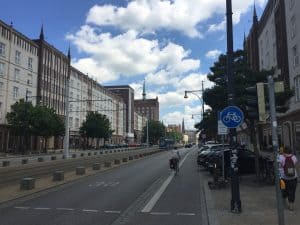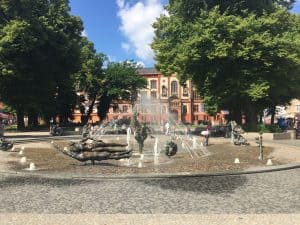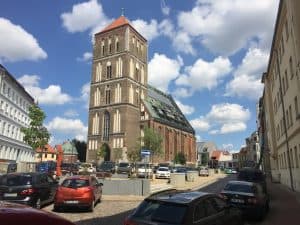After the great family gathering in Amstelveen, we drove back to Flensburg. What should have been a 5½ hour journey took 8½ hours due to a succession of road works and long queues on the autobahns, so we were very glad to get back on board and return to our cruising ways.
On the Saturday we had a fresh and fair breeze to take us out of the Flensburg Fjord and east to Bagenkop on the Danish island of Langeland, where we paused overnight. The next day we had a good sail southwards to the German coast, through the Fehmarn Sound and on south to the River Trave. We entered through Travemünde and found a quiet anchorage in the Pötenitzer Wiek, a nice lake off the river itself. Then on Monday we travelled 10nm up the river, mostly motoring, to reach the historic city of Lübeck.
To understand about Lübeck, you need to know about the Hanseatic League. Those familiar with this may want to skip the rest of this paragraph. Back in the 12C a group of Middle Low German speakers started trading with Novgorod (in present day Russia), taking products such as cloth and salt fish and bringing back pelts, spices and silk which had reached Novgorod from the East along the Silk Road. To negotiate with the Prince of Novgorod they formed themselves into a Hanseatic League or Hansa. They prospered and soon developed their base in what became Lübeck, which was ideally situated on an island in the River Trave and also had canal access to the Elbe and hence Hamburg. The Hansa merchants were granted complete control of Lübeck, establishing their own laws. They ran it for their own benefit and became fabulously wealthy. In due course other cities sprang up along the coast modelled on Lübeck. The principle others included Wismar, Rostock, and Strahlsund. There were a hundred lesser ones, forming a kind of free trade network – a predecessor of the European Free Trade Association. In addition to the cities, many hundreds of Kontors or trading posts were established stretching from the Mediterranean to Iceland. Kontors were outside the jurisdiction of the host country, much as an embassy is today. There were several on the east coast of England, the principle one being on the Thames close to what is now Canon Street Station and known as the Steel Yard. It became a walled compound and a self-contained community. In the 15C, conflict flared up between the English and the Hansa, the English disliking the presence of foreigners and ignoring the Hansa privileges. Trade wars and embargoes resulted until the Hansa took military action against England, helping Edward IV conquer the English throne in the Wars of the Roses. [So anti-European suspicion is nothing new – we wait to see what happens this time around.] Eventually, the monopoly of the Hansa declined as the trade with the Americas brought competition and by the late 16C it was no more. Today the cities still style themselves Hanseatic, the national airline is Lufthansa and we see Hanse Yachts on the water.
We loved Lübeck, spending three days exploring the city, visiting the European Hanseatic Museum and having a tour of the extraordinary city hall, where the Hansa ran their league. We also discovered Hüxstraße, full of delightful cafés and restaurants but off the tourist route.
- Holstentor
- Warehouses
- 13C hospital
- Rathaus
- Rathaus
We left Lübeck and stopped overnight in an anchorage down the river before setting off for Wismar the next morning. As we approached Wismar we found it very warm and did not fancy going straight into a city again, so we anchored off in the Wismar Bucht. We had a lovely evening and swam repeatedly, even just before going to bed.
Suddenly at about 3:00am we were hit by the most violent thunderstorm. The sky lit up continuously and the boat was rocked by winds which I measured up to F9 but the person I spoke to the next day claimed to have measured gusts over F12! We were thrown about and dragged our anchor rapidly towards some hazards. We had to rush to action stations – no time to get dressed apart from donning life jackets. I got the engine started while Ynskje crawled along the deck to get the anchor up. Eventually we managed to get the boat under control, gain deeper water and hold the boat there until the wind abated. About 5:00am we crawled back into our bunk.
For various reasons none of the three mobile phone SIMs we have been using in Germany were working and so we had turned in on Thursday night without any means of following the UK referendum results. When the storm hit we sensed instantly that the news was bad – the gods seems to be making their views known in no uncertain terms. The next morning we crept into Wismar port hardly daring to show our UK ensign.
One fall-out from the storm was the loss of Tony’s laptop, whose trackpad has gone rogue. This computer was our main navigation system. We are in what was East Germany and it is noticeable that things are less up to date here. There is no Apple dealer even in Wismar. Our backup plan is to use Ynskje’s laptop and we spent much of Friday restoring backups onto it and, crucially, getting the copy-protected navigational charts working. Update: Tony’s laptop is working again after drying out. It now sports Sellotape over the edges of the trackpad to block water from wet hands.
We have spent two days in Wismar – another fine Hansa city with vast brick gothic buildings and which was badly damaged by bombing in WWII. We are now in what was East Germany and the restoration work is not as advanced as in Lübeck, so it gives a chance to see how it was earlier.
On Sunday we had a fine sail further eastwards. The coast line in these parts is low, sometimes with little cliffs and often wooded. It lined with magnificent long golden sandy beaches, which are mostly empty. There is the occasional resort with its rows of wicker beach chairs. We came eventually to Warnemünde, which is a vast and busy port filled with cruise liners, Scandinavian ferries and other shipping. We threaded our way through and 6nm up the River Warnow to the Hanseatic city of Rostock.
 Rostock is big.
Rostock is big.
It grew industrially in the 19C and in WWII had major ship building and aircraft factories. It was virtually flattened by bombing, before becoming part of communist East Germany.
Since then it has been gradually rebuilt, starting in the 1950s with the Lange Straße, in which Communist grandeur echoes that of the Hanseatic age and its brick gothic style.
This might seem a bit kitsch, but actually seems to have worked well.
- Apartments inspired by
- Kröpliner Tor
- Even prefab blocks link to Gothic Brick
- Rathaus
 Throughout the city we found numerous sculptures, mostly in bronze, many from the communist era.
Throughout the city we found numerous sculptures, mostly in bronze, many from the communist era.
For example, outside a shoe shop was a sculpture of giant shoes of brick.
Good use is made of water and we particularly liked the Joy of Life fountain in the University Square.
The university dates from 1419 and is said to be the oldest in northern Europe.
 There were four vast churches in the Hanseatic times, all of which were war damaged. One was subsequently demolished but three remain. Since the collapse of communism they are gradually being restored. Even here there were surprises. Look at the photo of the St. Nikolaikirche. On the ground floor it is, once again, a church, while in the vast roof are four floors of apartments!
There were four vast churches in the Hanseatic times, all of which were war damaged. One was subsequently demolished but three remain. Since the collapse of communism they are gradually being restored. Even here there were surprises. Look at the photo of the St. Nikolaikirche. On the ground floor it is, once again, a church, while in the vast roof are four floors of apartments!
That’s our news for now.
Love from Tony & Ynskje










Hi Tony and Ynskje,
Sounds like you’re have a whale of a time and the photos are really impressive. The weather looks great too – lucky you.
I’m muddling along as usual and living fairly quietly which suits me.
Hi Dad and Ynskje,
Very interesting post and nice photos. I remember visiting Luebeck myself. The other Hansa cities look storied in history too.
Best wishes Rick